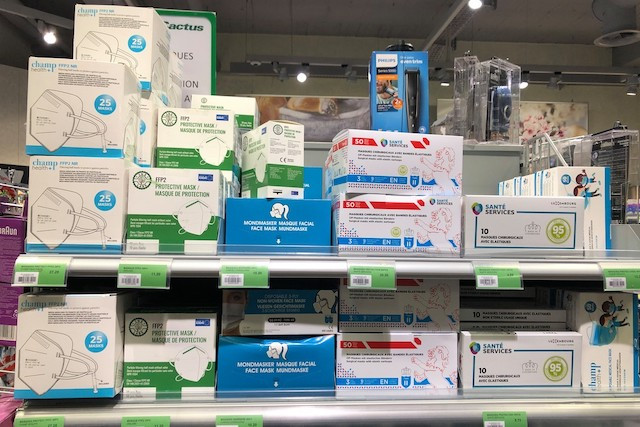How can masks with such different prices offer equal health protection? How can we believe that their quality is equivalent? Such questions easily arise, especially when faced with the variety of prices for the same quantity of masks from one store or pharmacy to another.
There are, in fact, three categories to be distinguished, according to the the Luxembourg institute for standardisation, accreditation, safety and quality of products and services (Ilnas). There are "surgical" masks, those known as "barrier" and "protective" masks.
"Doctors from the health directorate are responsible for monitoring the market, including imports" regarding"surgical masks", as explained to Paperjam. Masks are covered by the grand-ducal regulation of 11 August 1996 relating to medical devices. They must bear the CE mark to be placed on the market.
The same applies to “protective” masks, commonly called FFP 1, 2 and 3, which are covered by a European regulation of 9 March 2016 relating to personal protective equipment (PPE) and which are in turn controlled by Ilnas. They are often white with a "duckbill" shape.
Pay attention to the name
The third category, "barrier" masks, do not bear a CE mark, on the other hand, which would be "abusive" according to Ilnas, responsible for the control of them. These masks can be made of fabric--therefore easily recognisable--but also disposable. Without specific regulations, they are governed by the law of July 31, 2006, on general product safety. To recognise them, you should normally refer to the name written on the packaging. They’re also called alternative, anti-pollution or comfort masks.
More or less restrictive tests
Beyond their name and the regulations that govern them, what’s the difference between these types of masks? So-called "protection" masks are considered to be more efficient, since they filter from 80% (for FFP1) to 99% (for FFP3) of aerosols with a diameter of 0.6 microns. The government site dedicated to covid-19 states that they are "in principle reserved for health professionals or even vulnerable people as well as people who test positive".
The "surgeons" also undergo "stringent tests" according to Ilnas. Depending on the type (from I to IIR), they must filter between 95 and 98% of 3 micron aerosols. But we are talking here about "bacterial" filtration. Covid-19, however, is caused by a virus. With regards to the pandemic, such masks "avoid projections", according to Ilnas.
“Barrier” masks, for their part, are not expected to meet such criteria, but are checked, like any product, on other aspects, such as the absence of carcinogenic materials, tracing, the readability of the leaflet, etc. "This does not mean that they do not protect,” Ilnas nevertheless insists. Like “surgical” masks, they “avoid large projections”.
In places where wearing a mask is compulsory in Luxembourg, “barrier” masks are as easily accepted as surgical or FFP2 masks. In its 6 January 2021 opinion the health ministry specified all the same that "in general, it is recommended to favour surgical masks [over] alternative masks", defining the alternatives as fabric ones.
In France, fabric masks should no longer be worn at school or in business. Austria has decided to make FFP2 compulsory in public transport or shops.
From administrative control to the laboratory
What do Ilnas controls look like? They are done "by sampling, at the various points of sale which offer masks", according to its “market surveillance” department. Stores, pharmacies, markets, websites, etc. It determines the precise places “following analyses carried out on the basis of the experience of Ilnas, news, exchanges with other EU member states, etc.” Or reactively when it receives external notifications, from the European safety gate alert system, or from users.
Most of the time, the institute checks that the protective masks carry the CE standard. If not, they should be withdrawn from sale. Any seller not in compliance with Ilnas' request risks a fine of up to €15,000. The Ilnas carries out administrative checks, asking for the technical documentation of these masks. In case of doubt, they can be sent to the laboratory for further testing.
“Another important aspect is to check that the products do not contain incorrect information that could mislead the user. For example, a fabric barrier mask shouldn't have indications that it is personal protective equipment."
42 irregularities at 166 points of sale checked
Out of 166 controlled sites, including 56 pharmacies, 42 sale bans have been issued since the start of the crisis. Ilnas also controls online sales but was unable to provide the figures requested by Delano’s sister publication, Paperjam.
It also carries out checks on products imported from third countries, in collaboration with the customs and excise administration. 216 import requests were received, including 122 for "protective" masks, 80 for "barrier" masks and 14 for other personal protective equipment, such as gloves. 17 times the request was refused.
To deal with these increasing demands, the market surveillance department has increased its workforce from two to eight employees in the field of personal protective equipment.
A ministerial decree authorised, during the state of crisis which lasted until June 2020, making PPE available on the market, "even if they do not comply with the provisions of Regulation (EU) 2016/425 of the European Parliament and of the Council of 9 March 2016 relating to personal protective equipment and repealing Council Directive 89/686/EEC, provided however that they do not present a risk to health and safety ”, which Ilnas assures it had observed.
This article was originally published in French on Paperjam.lu and has been translated and edited for Delano.
